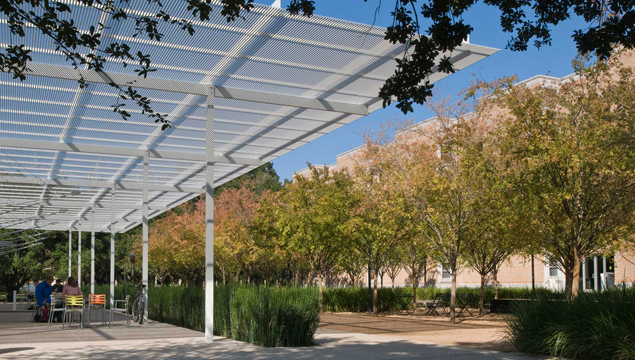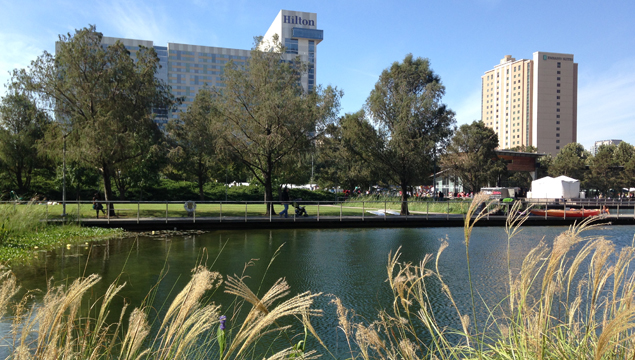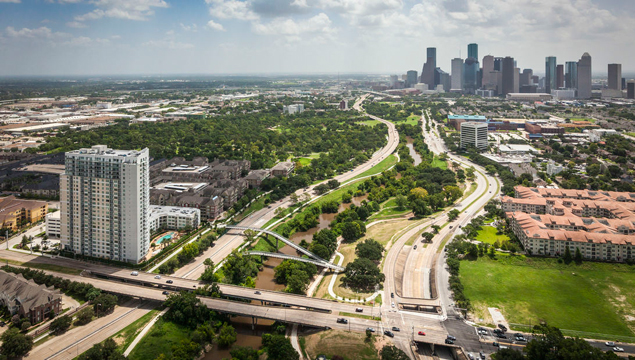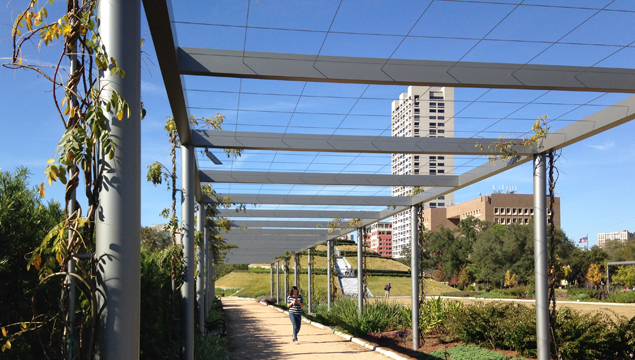The Houston Transformation and the City Beautiful: A Discussion with Andrew Albers and Ernesto Alfaro

The Brochstein Pavilion. Photo courtesy of The Office of James Burnett
In the interview that follows, Raj Mankad, the editor of Cite magazine, asks Andrew Albers and Ernesto Alfaro, who co-teach a survey of landscape architecture course at the Rice School of Architecture, about Houston’s landscapes. Albers is vice president at The Office of James Burnett, and Alfaro is a senior associate at SLA Studio+Land.
Mankad: We are outside Brochstein Pavilion at Rice University on a gorgeous day. Simply to sit outside is a testament to Houston’s transformation.
Alfaro: We didn’t have spaces like this before.
Albers: I moved to Houston as a graduate student in 1996. I was expecting tumbleweeds and cows in the streets, everybody would have cowboy hats. I had no idea. Riding my bike around campus for the first time, it was beautiful and green, but I noticed it was not really geared toward people using the space outside. There were no places to stop. No seats with a back. There was nobody outside.
Alfaro: Rice is a microcosm for what is happening across Houston. All of a sudden, you have a lot more buildings. With buildings you need the connective tissue.

Discovery Green. Photo by Allyn West
Mankad: Not long after Brochstein Pavilion was completed, Discovery Green (by Hargreaves Associates) opened in 2008, drawing crowds to what had been surface parking lots. It spurred a wave of construction along its borders. During the recession, Houston experienced a pause, though many projects were in planning stages. Last year, the Hermann Park McGovern Centennial Gardens (by Hoerr Schaudt and White Oak Studio) and Buffalo Bayou Park (by SWA Group) opened. Emancipation Park (by Philip Freelon and M2L Associates) is almost complete. The remaking of the Houston Arboretum (by Design Workshop and Reed Hilderbrand) and Memorial Park (by Nelson Byrd Wolz) are underway. The largest of all, Bayou Greenways, is making steady progress. West 8 was chosen for the Houston Botanic Garden. Now, Houston is commanding national attention for what has been one of our greatest failings—public space. How did this happen?
Alfaro: It was the perfect storm, the coalescing of lots of forces at the same time. Perhaps most important is people across the demographic spectrum becoming more aware of environmental issues. Not just being more aware of the environment but giving a damn and wanting to enjoy the outdoors.
Albers: The dream for large parks connected by linear trails along the bayous has been around for 100 years.
Mankad: Let's go to those roots, the 1912 Arthur Comey report. Comey was a student of Frederick Law Olmsted Jr. Comey’s proposal spurred Houston to acquire land for a system of parks linked by the bayous. Wars, the Depression, and floods halted those plans. Many of the bayous were channelized and lined with concrete. They were seen as drainage ditches and no more. Activists, civic leaders, and organizations like Rice Design Alliance, Buffalo Bayou Partnership, and others advocated for a more sensitive approach. Bayou Greenways is built on the backbone of that acquired land and the concept of Comey’s plan. Are we seeing the fulfillment or the reinvention of an old dream?
Albers: I think it is the reinvention. The City Beautiful Movement that Comey came out of was a response to cities developing rapidly without planning. The industrial revolution created poor living conditions, tenement housing, no spaces for the public. The city was a place for economic opportunity, but it wasn't the place where you wanted to be. The City Beautiful movement was about addressing the core conditions, making the city livable for those of means as well as creating beautiful public places. The theory was that because you are in a beautiful space, you will become a better person.
Alfaro: A better citizen and a more moral person.
Albers: There was a moral program to the movement. Today, the citizenry is seen as clients, as consumers.
Alfaro: You had people like Jane Jacobs looking at City Beautiful as an architectural cult imposed on everyone else. Now the landscape is conceived of as ecological restoration, which, to some extent, bypasses aesthetics. The connection to natural systems and the understanding of ecological processes take the role of the socio-moral imperative of the City Beautiful Movement. These parks are also important to the marketability of the city. The lead photo in the recent “36 Hours in Houston” article in the New York Times is Buffalo Bayou Park, front and center. It is the icon of the city. We are the Bayou City. Here it is. You can play in the Bayou City. This marketability is tied to the change in demographics. The same article notes that Houston has the highest concentration of Millennials among large cities.

Buffalo Bayou Park. Photo courtesy of SWA Group
That said, there are some parallels to the movements, if what we are looking at now is a movement. The City Beautiful movement was trying to address income inequality, which, to a great extent, is happening now as well. The eastern side of Houston should be developed more for exactly that reason.
Albers: To finance these great projects, the city works through nontraditional ways, such as public-private partnerships. These organizations help create endowments. They package funds. This means you don't have to go through as much government approval. What that seems to do, though, is to leave areas underserved.
Mankad: In some cases, low-income neighborhoods are getting attention. Bayou Greenways, which received $100 million of funding through a public bond, are along almost all the bayous in the city.
Alfaro: The private side of the financing is critical to the operation and maintenance of the parks, which typically the government can't sustain. Hermann Park, perhaps, was the early model in Houston. It was a long neglected city park. RDA held the Heart of the Park competition, which helped bring about a new nonprofit that commissioned Laurie Olin to do the master plan (1995). The latest addition, the Centennial Gardens, is one of those projects that will have a profound impact.

The McGovern Gardens. Photo by Allyn West
Albers: The big move is a mount with a snail trail to the top. It puts landscape front and center. It is a landscape skyscraper. Houston is so flat. You are hyperaware of any sort of mound or hill. There's almost an innate desire to go up and down. The most popular piece of playground equipment at schools is the pile of dirt or grassy mound.
Alfaro: The Jerusalem Thorn trees in the parking areas look fantastic. They have this beautiful yellow flower. A grove of crape myrtles. Then you look at the ground cover, the texture, the trees. The juxtaposition of those materials, walking and paving materials, the planting materials, that's the kind of education you get when you walk through that garden. It is so compact. For a long time, the site was the back end of Hermann Park. No one knew what to do with it. That's the beautiful thing about design in general, and landscape architecture in particular. The sites that are problems are where there are opportunities. And we have so many opportunities in Houston! I won't speak for you all, I will speak for myself. I thought that Houston was an incredibly ugly city.
Albers: And now, you wouldn't believe the transformation.
(Access to the full discussion can be found at OffCite, a website maintained by the Rice Design Alliance.)



